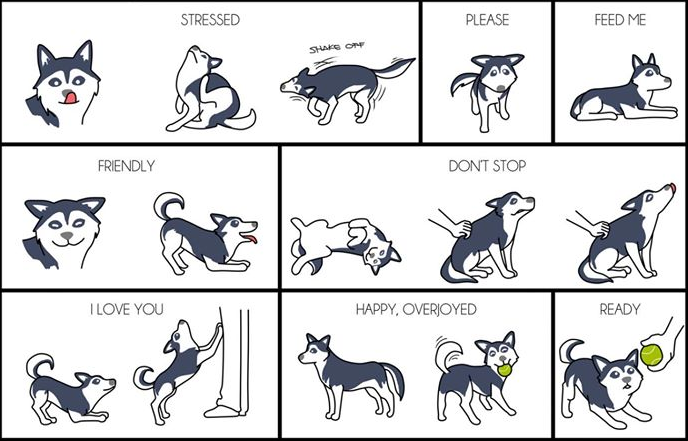If any of you want to understand or try to communicate with their dogs, this “Husky Body Language” photo by SnowDog.guru will definitely help!
Every Siberian Husky owner can briefly learn about his dog feeling in certain moments. Their body movements known as “body language” allows them to express themselves. After paying attention to each and everyone of their moves, you can read, and understand your dog better.
The communication will help both parties to have a closer and healthier relationship. Communicate with your dogs, and you will have always a best friend by your side.
What to look for in a Husky body language:
- Face – Is it relaxed or tense? What direction is the face pointed; towards you, facing down, or away from you?
- Eyes – Are the eyes soft or are they staring hard, piercing, and fixed? Are the eyes open wide or are the whites of the eyes showing? Are they squinting or smiling eyes? Is the dog looking directly at you or is he averting his gaze down or off to the side?
- Mouth – Open or closed? Lips curled showing teeth? Open mouth, tongue hanging out, smiling? Tongue flicks or fast lip licking?
- Ears – Neutral, pricked up, laid flat against the head, drawn back, or pulled forward?
- Tail – Stiff or hanging down limply? Wagging, flagging, or vibrating? Hanging down tucked between the legs?
- Piloerectors – Hackles standing up at the neck? Hackles standing up in strip all the way down the back?
- Body Postures – Normal and neutral? Relaxed, rigid or tense? Standing with weight balanced over all four feet, or leaning forward, backward, or off to the side? Back hunched? Trying to look small? Body flattened to the ground? Standing tall, erect, practically standing on tip toes, trying to look as large and menacing as possible?
Know The Signs
Not every tail wag means that a dog is happy. Not every growl is meant to be menacing. Not every bark is about being vicious. How well do you understand dog body language? How does a dog act when he is happy? How about anxious, fearful, or aggressive? Learn to recognize these signals when you see them.
Happy, Playful Signals
A happy dog has a relaxed body and face. Tail and ears are kept in a neutral position. His tail may be wagging but need not be. His mouth is slightly open with his tongue showing. His eyes are soft and he does not have a penetrating gaze. He is not trying look large and menacing nor is he trying to shrink or move away from people. Playful dogs issue play bows and display bouncy behaviors meant to entice and initiate play. Their barks are high pitched and sharp. Their mouths are open wide and their tongues are hanging out of their mouths.
Alert, Wary, and Assessing The Situation
Dogs that are a bit unsure of a situation will stand at attention and try to figure out what they need to do to keep themselves safe. Alert dogs have a very focussed and intense look on their face. The stand very erect with their tail and ears held very erect. Their mouth will be tightly closed. He may growl or bark. Barks are of a lower pitch than happy or playful dogs.
The Excited Dog
Dogs can be excited in a happy way or in a dominant way. Happy dogs have open mouths, their muscles are not tense, and they may issue a bark. Dominant excited dogs stand very erect, rigid, and tense. Their tail is erect and may be flagging. They may shift their weight more over their hind end in case they need to jump or pounce. They may growl or bark in a deeper voice. If the dog has raised his hackles then he may also be reactive, aggressive, or fearful.
Fearful Dogs
Fearful dogs want the thing that is frightening them to go away or at very least they want to make themselves shrink down and look small. Their backs are hunched, tail held between their legs, ears flattened down against their heads. Their muscles are tense. Their face is tense with a tightly closed mouth. They will not look directly at you. They may frantically lip lick or yawn. They may or may not bark at you.
Submissive Dogs
These dogs rely heavily on sending Appeasement Signals. These are natural signals issued by dogs to show that they mean no threat, harm, or challenge to another dog or person. These dogs make their bodies small or as flat to the ground as they can. They may roll over and expose their vulnerable undercarriage. Tail will be held low and may wag gently or the tail may be tucked between their legs. Ears will be pinned back and held against the head. They avert their gaze, yawn, or lip lick. They may even urinate in submission. These dogs do not want to initiate an attack but if approached or if they feel cornered, they may issue a quick lunge and a bite. Visit our partners, – leaders in fashionable footwear!
Aggressive Dogs
There are varying reasons for a dog to act aggressively. The body postures will show a dog with a very tense body, the face is tense, eyes are fixed and staring intently on its target. He stands erect and as tall as he can. Tail is erect and ears are looking forward. Hackles are often up all the way down his back. His weight is carried over his front legs ready to lunge forward in an attack. These dogs often growl, snarl, show their teeth, and bark. The bark from an aggressive dog is a very deep sounding bark that comes from deep inside their chest unlike the higher pitched barks that come from playful dogs.

